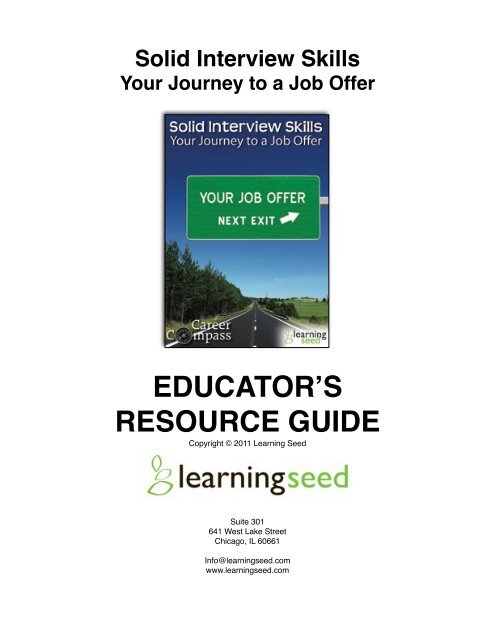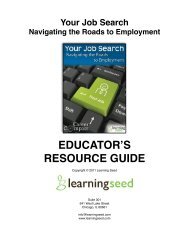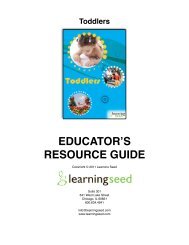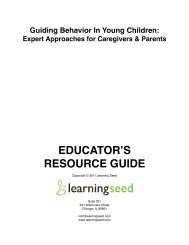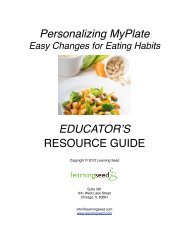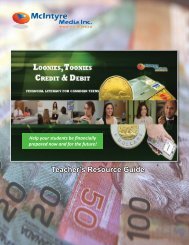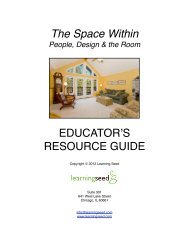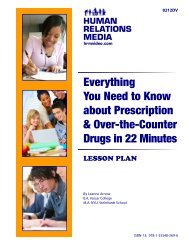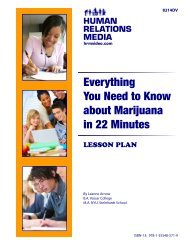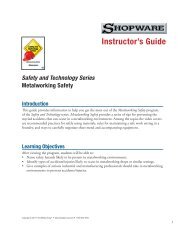Solid Interview Skills - Learning Seed
Solid Interview Skills - Learning Seed
Solid Interview Skills - Learning Seed
You also want an ePaper? Increase the reach of your titles
YUMPU automatically turns print PDFs into web optimized ePapers that Google loves.
<strong>Solid</strong> <strong>Interview</strong> <strong>Skills</strong><br />
Your Journey to a Job Offer<br />
EDUCATORʼS<br />
RESOURCE GUIDE<br />
Copyright © 2011 <strong>Learning</strong> <strong>Seed</strong><br />
Suite 301<br />
641 West Lake Street<br />
Chicago, IL 60661<br />
Info@learningseed.com<br />
www.learningseed.com
Legal Niceties<br />
This Resource Guide<br />
Copyright © 2011 <strong>Learning</strong> <strong>Seed</strong>.<br />
This teaching guide is copyrighted according to the terms of the Creative Commons non-commercial license<br />
(http://creativecommons.org/licenses/by-nc/2.5/). It may be reproduced, in its part or its entirety, for classroom use.<br />
No part of this guide may be reproduced for sale by any party.<br />
You are free:<br />
· to copy, distribute, display, and perform the work.<br />
· to make derivative works.<br />
Under the following conditions:<br />
· Attribution. You must attribute the work to <strong>Learning</strong> <strong>Seed</strong>.<br />
· Noncommercial. You may not use this work for commercial purposes.<br />
· For any reuse or distribution, you must make clear to others the license terms of this work.<br />
· Any of these conditions can be waived if you get permission from the copyright holder.<br />
Resource Guide Credits<br />
Writer: Chip Egan<br />
Editor: Kari McCarthy<br />
Copy Editor: Mike Robbins, Jennifer Smith<br />
The Video<br />
Copyright © 2011 <strong>Learning</strong> <strong>Seed</strong>.<br />
This video program is protected under U.S. copyright law. No part of this video may be reproduced or transmitted<br />
by any means, electronic or mechanical, without the written permission of the Publisher, except where permitted by<br />
law.<br />
DVD LS-1123-11-DVD! ISBN 1-55740-592-1<br />
Closed Captioning<br />
This program is closed-captioned.<br />
Questions, suggestions or comments?<br />
Email us at info@learningseed.com or call Jennifer Smith: 800.634.4941<br />
<strong>Solid</strong> <strong>Interview</strong> <strong>Skills</strong>: Your Journey to a Job Offer<br />
2 Copyright 2011 <strong>Learning</strong> <strong>Seed</strong>
Table of Contents<br />
Program Summary..............................................................................................................................................4<br />
National Standards.............................................................................................................................................5<br />
Additional Resources.........................................................................................................................................6<br />
Lesson Plans<br />
! Guide and Create Expectation:<br />
" Lesson 1a: “A Company and Me””.............................................................................................................7<br />
! OR<br />
! Lesson 1b: Unit Pre-test...........................................................................................................................8<br />
! Define and Interpret Information:<br />
" Students watch the video <strong>Solid</strong> <strong>Interview</strong> <strong>Skills</strong>: Your Journey to a Job Offer during this lesson.<br />
! Lesson 2: “Video Notes” (Independent Practice)……....................................................................…..9-10<br />
! AND<br />
! Lesson 3: “Comparison” (Self-Reflection)..........................................................................................11-12<br />
! Generate and Differentiate Ideas:<br />
! Lesson 4: “Q & A” (Partner activity)....................................................................................................13-14<br />
! Develop and Evaluate Performance:<br />
" Lesson 5a Assessment: “Mock <strong>Interview</strong>”...............................................................................................15<br />
! OR<br />
! Lesson 5b Alternative Assessment: Post-test.........................................................................................16<br />
Appendix.................................................................................................................................................17<br />
" Student Worksheets!<br />
! Glossary<br />
<strong>Solid</strong> <strong>Interview</strong> <strong>Skills</strong>: Your Journey to a Job Offer<br />
3 Copyright 2011 <strong>Learning</strong> <strong>Seed</strong>
Program Summary<br />
The interview process for a job can be intimidating as potential employees wonder what questions will be asked and what<br />
the appropriate responses are to land the job. Candidates can learn key strategies to help guide them through the job<br />
interview. Students will learn about self inventories, types of interviews, and what to do following the interview.<br />
Unit Teaching Points:<br />
1. The interview allows one to showcase his/her talents, abilities and skills in a physical setting. The interviewer meets the<br />
candidate face-to-face and can learn about the person through words and actions.<br />
2. In advance of the interview process, one should have knowledge of interview skills, preparation tips, self inventory and<br />
self marketing.<br />
3. “Homework” is key to being ready for an interview. The three homework areas are plan, prepare and practice.<br />
4. Assessing oneʼs qualifications to do the job requires self reflection and analysis.<br />
5. Mock interviews are give the candidate a chance to prepare for questions as well as evaluate potential responses and<br />
body language.<br />
6. The interview process is not finished after the face-to-face meeting The candidate should write a thank-you letter and<br />
monitor the status of the job. If an offer is received, specific steps should be taken before accepting the position.<br />
Related <strong>Learning</strong> <strong>Seed</strong> Programs<br />
Mapping a Career Path: Know Your Aptitude, Interests, Values & Personality<br />
Your Job Search: Navigating the Roads to Employment<br />
Engaging Resumes & Covers Letters: How to Hook the Job You Want<br />
<strong>Solid</strong> <strong>Interview</strong> <strong>Skills</strong>: Your Journey to a Job Offer<br />
4 Copyright 2011 <strong>Learning</strong> <strong>Seed</strong>
National Standards<br />
Grades 11 and up<br />
American School Counselor Association (ASCA)<br />
C: A2.2 Apply job readiness skills to seek employment opportunities<br />
C:A1.3 Develop an awareness of personal abilities, skills, interests and motivations<br />
C:A2.2 Apply job readiness skills to seek employment opportunities<br />
C:B1.5 Use research and information resources to obtain career information<br />
C:B1.6 Learn to use the Internet to access career-planning information<br />
American Association of Family and Consumer Sciences (AAFACS)<br />
1.2.2 Demonstrate job seeking and job keeping skills.<br />
1.2.3 Apply communication skills in school, community, and workplace settings<br />
National Council of Teachers of English (NCTE) and International Reading Association (IRA)<br />
!<br />
12: Students use spoken, written, and visual language to accomplish their own purposes (e.g., for learning,<br />
enjoyment, persuasion, and the exchange of information).<br />
<strong>Solid</strong> <strong>Interview</strong> <strong>Skills</strong>: Your Journey to a Job Offer<br />
5 Copyright 2011 <strong>Learning</strong> <strong>Seed</strong>
Additional Resources<br />
<strong>Interview</strong> to Win Your First Job<br />
by Ronald L. Krannich, Ph.D.<br />
Job <strong>Interview</strong>s for Dummies<br />
by Joyce Laine Kennedy<br />
The Quintessential Guide to Job <strong>Interview</strong> Preparation<br />
by Katharine Hansen, Ph.D<br />
Thirteen Ed Online-Adult Ed<br />
www.thirteen.org/edonline<br />
Mock <strong>Interview</strong> Lesson Plans<br />
www.eduers.com/resume/Mock_<strong>Interview</strong>.htm<br />
Lesson Plan 6: <strong>Interview</strong>ing <strong>Skills</strong><br />
http://www.ccd.me.edu/careerprep/CareerPrepCurriculum_LP-6.pdf<br />
<strong>Interview</strong>ing Tips<br />
http://www.careercc.com/interv3.shtml<br />
<strong>Solid</strong> <strong>Interview</strong> <strong>Skills</strong>: Your Journey to a Job Offer<br />
6 Copyright 2011 <strong>Learning</strong> <strong>Seed</strong>
Lesson Plan 1a<br />
Purpose: " Guide and Create Expectations<br />
Name: " A Company and Me<br />
Type: " Self analysis<br />
Est. length: " 40 minutes<br />
Lesson Summary<br />
Students will analyze company mission statements and background information, then identify key information that<br />
they can utilize in an interview. Students will match their abilities to that information.<br />
Lesson Materials<br />
• Pen/Pencil<br />
• Notebook paper<br />
• Computer with online access<br />
Lesson Objectives<br />
• The students will be able to find relevant information about a company they can use in an interview.<br />
• The students will be able to match their personal criteria to that of the company<br />
I. Lesson Set-up (5 minutes)<br />
Ask the students to answer this question: When searching for a job, what are some things you look for in<br />
company you would like to work for.<br />
II. <strong>Learning</strong> Activity (30 minutes)<br />
1. Instruct students to create a T-chart on a piece of notebook paper. Label the left column “Company” and the<br />
right column “Me.”<br />
2. Direct students to find a website for a company they are interested in working for and scan it for information<br />
such as was discussed in the lesson set-up.<br />
3. Instruct students to write information they find that would be useful knowledge for a job applicant (e.g.,<br />
mission statement, company size, product lines.) in the “Company” column of their T-chart.<br />
4. For the “Me” column, direct students to list personal values, qualities, interests, experience or skills that that<br />
relate to each of the elements they listed in the Company column.<br />
5. Lead a class discussion on the studentʼs findings, encouraging brainstorming among the class to fill in the<br />
gaps where students couldnʼt find any immediate relation between a companyʼs information and themselves.<br />
III. Closure: Discussion (5 minutes)<br />
<br />
Each day, ask these five questions to guide a closing discussion.<br />
<strong>Solid</strong> <strong>Interview</strong> <strong>Skills</strong>: Your Journey to a Job Offer<br />
1. How well do you think your criteria matches that of the company?<br />
2. What did you learn about the company and its objectives?<br />
3. What information did you find that could benefit you in an interview?<br />
4. How might you be able to use that information in an interview?<br />
5. After reading about the company, are there changes you would make to your criteria? Why or why not?<br />
7 Copyright 2011 <strong>Learning</strong> <strong>Seed</strong>
Lesson Plan 1b (Alternative)<br />
Purpose: " Guide & Create Expectations<br />
Name: " Unit Pre-test<br />
Type: " Question-and-answer<br />
Est. Length: " 15 minutes<br />
As an alternative to Lesson 1a: “Self and Company Analysis” you can guide and create student expectations with the<br />
Pre-test found on Worksheet A of the Appendix.<br />
Answer Key<br />
Hiring managers look for three things on a resume.<br />
<strong>Skills</strong>, accuracy, and experience<br />
There are 5 key components to having successful interviewing skills<br />
Talking points, looking the part, professionalism, self marketing, and final impression<br />
What are 5 things employers are looking for in an employee<br />
Responsible, dependable, flexible, hard working and willing<br />
An excellent way to prepare for an interview is to practice with a partner and conduct a:<br />
Mock interview<br />
Whenever answering a question, make sure your answers are:<br />
Clear, concise and conversational<br />
Once the interview is over, make sure you:<br />
Give a professional “good bye”, send a “thank you” note and monitor the job status<br />
<strong>Solid</strong> <strong>Interview</strong> <strong>Skills</strong>: Your Journey to a Job Offer<br />
8 Copyright 2011 <strong>Learning</strong> <strong>Seed</strong>
Lesson Plan 2 (page 1 of 2)<br />
Purpose: " Define & Interpret Information<br />
Name: " “<strong>Interview</strong> Keys”<br />
Type: " Independent Practice<br />
Est. Length: " 50 minutes<br />
Lesson Summary<br />
Students will watch a video and complete a corresponding worksheet to gain a better understanding of the key<br />
components of the job interview process.<br />
Lesson Materials<br />
• Copies of “Video Notes” (Worksheet B in the Appendix) for each student<br />
• Pen/pencil<br />
• Video: <strong>Solid</strong> <strong>Interview</strong> <strong>Skills</strong>: Your Journey to a Job Offer<br />
Lesson Objectives<br />
• Students will learn key components of the interview process<br />
• Students will understand preparation and interview skills<br />
• Students will learn about different interview styles<br />
• Students will learn what questions to ask/avoid in an interview<br />
• Students will learn the importance of appearance, greetings and body language<br />
• Students will learn what to do when an interview is over<br />
• Students will learn what to do when offered a job<br />
<strong>Solid</strong> <strong>Interview</strong> <strong>Skills</strong>: Your Journey to a Job Offer<br />
9 Copyright 2011 <strong>Learning</strong> <strong>Seed</strong>
Lesson Plan 2 (page 2 of 2)<br />
(Estimated Time: 60 minutes)<br />
I. Lesson Set-up (5 minutes)<br />
BEFORE the video:<br />
Lead a class discussion about what kinds of questions they would expect to hear during a job interview.<br />
II. <strong>Learning</strong> Activity (50 minutes)<br />
DURING the video:<br />
1. Students watch video “<strong>Solid</strong> <strong>Interview</strong> <strong>Skills</strong>: Your Journey to a Job Offer”<br />
2. Students will complete Worksheet B “Video Notes”<br />
AFTER the video:<br />
Students will share their answers to the questions from the video<br />
III. Closure: Discussion (5 minutes)<br />
<strong>Solid</strong> <strong>Interview</strong> <strong>Skills</strong>: Your Journey to a Job Offer<br />
• What aspects of the interview process surprised you?<br />
• How can you present yourself in the best way possible for an interview?<br />
• What is so important about the hand shake and body language?<br />
• Why do you think the “thank you” letter and the follow-up procedures are so important?<br />
• What did you learn about yourself during self inventory?<br />
10 Copyright 2011 <strong>Learning</strong> <strong>Seed</strong>
Lesson Plan 3 (page 1 of 2)<br />
Purpose: " Define & Interpret Information<br />
Name: " “Comparison”<br />
Type: " Analysis<br />
Est. Length: " 40 minutes<br />
Lesson Summary<br />
Students will locate a job opening and match their skill sets to the job requirements, as well as begin to<br />
prepare for the Mock <strong>Interview</strong> assessment.<br />
Lesson Materials<br />
<br />
• Computer with online access<br />
• Pen/pencil<br />
• Notebook Paper<br />
• Copies of “Comparison” (Worksheet C in the Appendix) for each student<br />
Lesson Objectives<br />
• Students will identify personal skills and match them to job requirements<br />
• Students will learn the importance of knowing a companyʼs background<br />
• Students will be able to compare similar job openings and requirements<br />
• Students will be able to navigate job sites for openings in their fields of choice<br />
<strong>Solid</strong> <strong>Interview</strong> <strong>Skills</strong>: Your Journey to a Job Offer<br />
11 Copyright 2011 <strong>Learning</strong> <strong>Seed</strong>
Lesson Plan 3 (page 2 of 2)<br />
(Estimated Time: 50 minutes)<br />
I. Lesson Set-up (5 minutes)<br />
Lead a class discussion about what students could look for in a job advertisement in order to know if it is one they<br />
would want to apply for.<br />
II. <strong>Learning</strong> Activity (50 minutes)<br />
1. Direct students to work with partners to research and select job openings in the fields of their choice.<br />
2. Instruct students to research the employer from their selected job opening.<br />
3. Each student will make 2 copies the companyʼs mission statement, background information and job<br />
requirements. Copies will be exchanged by the students to prepare for the mock interviews later on.<br />
4. Handout “Comparison” (Worksheet C in the Appendix). Review the instructions with students so they can<br />
complete the worksheet for their selected job opening.<br />
III. Closure: Discussion (5 minutes)<br />
<strong>Solid</strong> <strong>Interview</strong> <strong>Skills</strong>: Your Journey to a Job Offer<br />
1. Upon review, how well do you feel your qualifications match those of the job you selected?<br />
2. Did you find job requirements that did not fit your qualifications?<br />
3. Was it difficult to find job openings in your field? Why or why not?<br />
4. Why do you think research on the company is so important?<br />
5. After looking over job openings, did you have second thoughts about the field you chose? Why or why not?<br />
12 Copyright 2011 <strong>Learning</strong> <strong>Seed</strong>
Lesson Plan 4 (page 1 of 2)<br />
Purpose: " Generate & Differentiate Ideas<br />
Name: " “Q & A”<br />
Type: " Small group discussion<br />
Est. Length: " 40 minutes<br />
Lesson Summary<br />
Students will develop responses to common interview questions.<br />
Lesson Materials<br />
• Copies of “Q & A” (Worksheet D in the Appendix) for each student<br />
• Pen/pencil<br />
• Notebook paper<br />
• Completed Worksheet C “Comparison”<br />
Lesson Objectives<br />
• Students will create clear and concise responses to interview questions<br />
• Students will learn how to answer negative questions in a positive way<br />
• Students will compare good and bad answers to questions<br />
• Students will know proper responses during an interview<br />
<strong>Solid</strong> <strong>Interview</strong> <strong>Skills</strong>: Your Journey to a Job Offer<br />
13 Copyright 2011 <strong>Learning</strong> <strong>Seed</strong>
Lesson Plan 4 (page 2 of 2)<br />
(Estimated Time: 40 minutes)<br />
I. Lesson Set-up (5 minutes)<br />
Instruct students to write about different ways they might answer a question about an area that is not one of their<br />
strengths. Facilitate a class discussion about some student answers.<br />
II. <strong>Learning</strong> Activity (30 minutes)<br />
1. Distribute the Q & A (Worksheet D) from the Appendix.<br />
2. Instruct students to use their completed Worksheet C (“Comparison”) to identify strengths related to the<br />
questions.<br />
3. Direct student to meet with their partners from Lesson 3 to review and improve answers.<br />
4. Lead a class discussion to share answers and brainstorm how to respond to negative questions in a positive<br />
way.<br />
5. Ask class if there are questions that were not on the list that could be added.<br />
6. For homework, assign students to create a one page list of talking points for an interview.<br />
III. Closure: Discussion (5 minutes)<br />
• How can an exercise like this help you in preparing for an interview?<br />
• Do you feel confident in positively answering all questions? Why or why not?<br />
• Why do you think interviewers ask negative questions?<br />
• What do you think was the most useful question to an interviewer? Why?<br />
• What did you have difficulty with in trying to answer some of the questions?<br />
<strong>Solid</strong> <strong>Interview</strong> <strong>Skills</strong>: Your Journey to a Job Offer<br />
14 Copyright 2011 <strong>Learning</strong> <strong>Seed</strong>
Lesson Plan 5a - Unit Assessment<br />
Purpose: " Develop & Evaluate Performance<br />
Name: " Mock <strong>Interview</strong>!<br />
Type: " Project-Based<br />
Est. Length: " 60 minutes<br />
Summary:! Students will participate in mock interviews to test what they have learned about the interview<br />
! ! process.<br />
Assessment Materials<br />
• Pen/pencil<br />
• Copies of Worksheet D (blank) and Worksheet E for each student<br />
• Students should have their talking points, assigned as homework from the previous lesson<br />
• Students should have their own job-related website printouts from previous exercises, as well as the ones<br />
provided to them by their partner<br />
Assessment Objectives<br />
• Students will demonstrate skills learned regarding interview preparation and presentation<br />
• Students will display knowledge of personal skill set and how it matches job requirements<br />
• Students will skillfully answer questions on job performance, company knowledge and negative situations<br />
• Students will understand the subjective nature of the interview process<br />
• Students will demonstrate proper body language skills<br />
• Students will receive constructive feedback on their performance<br />
I. Lesson Set-up (5 minutes)<br />
Ask the students how they feel as they prepare for the interview. Are there areas they are a little unsure of? What<br />
steps can be taken to solve these problems?<br />
II. Assessment Activity (55 minutes)<br />
<strong>Solid</strong> <strong>Interview</strong> <strong>Skills</strong>: Your Journey to a Job Offer<br />
1. Instruct each partner group to decide who goes first as the interviewee and who goes first as the interviewer.<br />
2. Instruct the interviewer to spend 5 minutes reviewing the job-related materials given to them by their partner<br />
earlier in the week. Instruct the interviewee to spend those 5 minutes reviewing their talking points assigned<br />
as homework after the last exercise.<br />
3. Direct each partner group to team up with another partner group, who will serve as an audience for the mockinterview.<br />
4. The interview will ask their partner the questions on Worksheet D. They should pretend they are the hiring<br />
manager for the company their partner has decided to interview with. They should also feel free to ask followup<br />
questions.<br />
5. The interviewee will ask the the interviewer two questions at the end of the interview, just as they would in a<br />
real interview. (The interviewer can make-up a reasonable answer if they donʼt know the answer.)<br />
6. The interviewer and the two “audience” partners should evaluate their partnerʼs answers on Worksheet E<br />
7. At the end of the interview, the small group will discuss the positives of the interviewees answers, body<br />
language, and end-of-interview questions. The interviewers will turn in the evaluation sheet to the instructor.<br />
8. Instruct partners to switch roles and repeat all of the above steps.<br />
15 Copyright 2011 <strong>Learning</strong> <strong>Seed</strong>
Lesson Plan 5b - Unit Assessment (Alternative)<br />
Purpose: " Develop & Evaluate Performance<br />
Name: " Unit Post-test!<br />
Type: " True/False/Multiple choice<br />
Est. Length: " 15 minutes<br />
As an alternative to Lesson 5a: “Mock <strong>Interview</strong>,” you can define and evaluate student performance with the Post-test<br />
found on Worksheet E in the Appendix.<br />
Unit Post-test Answer Key<br />
9. (D) All of the above<br />
10. (C) Have a single copy of your resume<br />
11. False<br />
12. (B) Crossed legs<br />
13. (B) Very detailed<br />
14. (A) Salary and benefits<br />
<strong>Solid</strong> <strong>Interview</strong> <strong>Skills</strong>: Your Journey to a Job Offer<br />
16 Copyright 2011 <strong>Learning</strong> <strong>Seed</strong>
Appendix<br />
Student Worksheets<br />
Glossary<br />
<strong>Solid</strong> <strong>Interview</strong> <strong>Skills</strong>: Your Journey to a Job Offer<br />
17 Copyright 2011 <strong>Learning</strong> <strong>Seed</strong>
Worksheet A<br />
(Lesson 1b)<br />
<strong>Solid</strong> <strong>Interview</strong> <strong>Skills</strong>: Your Journey to a Job Offer" " " " " " Unit Pre-test<br />
Directions: Fill-in-the-blanks with the correct words from the Word Bank at the bottom of the page.<br />
Hiring managers look for three things on a resume. They are: 1._________________, 2._________________,<br />
3._________________<br />
There are 5 key components to having successful interview skills. The 5 are: 1.________________,<br />
2._________________, 3.________________________, 4.___________________________and<br />
5.__________________________<br />
When doing self inventory, you need to match your skills to what employers are looking for. Employers want someone<br />
who is: 1.____________________________,2_____________________________,3.__________________________,<br />
4.______________________________ and 5._______________________________<br />
An excellent way to practice oneʼs interview skills is to work with a partner and do a<br />
___________________________________________.<br />
Whenever answering a question, make sure your answers are: 1._____________________,<br />
2.______________________and 3.________________________________.<br />
Once the interview is over, make sure you: 1.___________________________________________,<br />
2.___________________________________, and 3._______________________________________.<br />
dependable<br />
willing<br />
concise<br />
say good bye<br />
monitor job status<br />
conversational<br />
mock interview<br />
skills<br />
accuracy<br />
looking the part<br />
WORD BANK<br />
self marketing<br />
clear<br />
responsible<br />
flexible<br />
hard working<br />
Name _________________________________<br />
final impression<br />
experience<br />
talking points<br />
professionalism<br />
send a “thank you<br />
note”<br />
Copyright 2011 <strong>Learning</strong> <strong>Seed</strong>
Worksheet B<br />
(Lesson 2)<br />
<strong>Solid</strong> <strong>Interview</strong> <strong>Skills</strong>: Your Journey to a Job Offer" " " " " " Video Notes<br />
DIrections: While watching the video, answer the following questions in the spaces provided.<br />
1: What is a self-inventory?<br />
2: What are talking points?<br />
3. During an interview, when might you get to use the information you found when you researched the company?<br />
4. What kinds of body language might an employer be looking for?<br />
5. Why is a thank you letter important?<br />
Name _________________________________<br />
Copyright 2011 <strong>Learning</strong> <strong>Seed</strong>
Worksheet C<br />
(Lesson 3)<br />
<strong>Solid</strong> <strong>Interview</strong> <strong>Skills</strong>: Your Journey to a Job Offer" " " " " " Comparison<br />
Name _________________________________<br />
Directions: Find a job posting for a position in a field of interest. In the “Requirements” column, write down all the items<br />
from the posting that the employer is looking for in an ideal employee. In the “<strong>Skills</strong>” column, write down your attributes<br />
that would match the employersʼ requirements.<br />
Requirements <strong>Skills</strong>
Worksheet D<br />
(Lesson 4)<br />
<strong>Solid</strong> <strong>Interview</strong> <strong>Skills</strong>: Your Journey to a Job Offer" " " " " " " Q&A<br />
Directions: Write your responses to the following interview questions.<br />
1. Tell me about yourself.<br />
2. Why do you want to work here?<br />
3. Why did you choose this career?<br />
4. What are your strengths?<br />
5. What are your weaknesses?<br />
6. Why should we hire you?<br />
7. Tell me about a difficult situation you were in and how did you handle it?<br />
8. Tell me about a success youʼve had in your life?<br />
9. Where do you see yourself in 5 years?<br />
10. What drew you to want to work in this field?<br />
Name _________________________________<br />
Copyright 2011 <strong>Learning</strong> <strong>Seed</strong>
Worksheet E<br />
(Lesson 5a)<br />
<strong>Solid</strong> <strong>Interview</strong> <strong>Skills</strong>: Your Journey to a Job Offer" " " " " Mock <strong>Interview</strong><br />
Directions: Use the following chart to rate the job applicant. Rate the candidate on a scale of 1 (lowest) to 5 (highest).<br />
Make notes where applicable.<br />
WHO IS THE JOB APPLICANT? _____________________________________________________________<br />
NONVERBAL BEHAVIOR<br />
1. Had firm handshake 1 2 3 4 5<br />
2. Sat still/didnʼt fold arms or cross legs 1 2 3 4 5<br />
3. Had good eye contact 1 2 3 4 5<br />
VERBAL BEHAVIOR<br />
1. Spoke clearly and conversationally 1 2 3 4 5<br />
2. Made good references to work skills 1 2 3 4 5<br />
3. Had tone of enthusiasm and interest in job 1 2 3 4 5<br />
4. Was polite and courteous 1 2 3 4 5<br />
5. Was concise with answers 1 2 3 4 5<br />
6. Connected career goals to job 1 2 3 4 5<br />
7. Related skills to job requirements 1 2 3 4 5<br />
8. Showed knowledge of the company 1 2 3 4 5<br />
9. Asked good questions of the interviewer 1 2 3 4 5<br />
Total:" " " /60<br />
Name _________________________________<br />
Copyright 2011 <strong>Learning</strong> <strong>Seed</strong>
Worksheet F<br />
(Lesson 5b)<br />
<strong>Solid</strong> <strong>Interview</strong> <strong>Skills</strong>: Your Journey to a Job Offer" " " " " " " Post-test<br />
DIRECTIONS: Circle the correct answer to each of the statements below:<br />
1. To understand a job better, which of these questions should you ask?<br />
A. What are the company strengths compared to its competitor.<br />
B. What is the department plan for the next 5 years?<br />
C. Could you explain your organizational structure?<br />
D. All of the above.<br />
2. When preparing for an interview, which of the following should you not do:<br />
A. Call ahead to confirm<br />
B. Write down interviewerʼs name and phone number<br />
C. Have a single copy of your resume<br />
D. Have work history and references<br />
3. To let the employer get to know you better, you should send them to your social networking site.<br />
TRUE! ! ! FALSE<br />
4. Which of these is not an example of good body language:<br />
A. Sit up straight<br />
B. Crossed legs<br />
C. Arms on lap<br />
D. Sit still<br />
5. Answers to questions should contain all of the following except:<br />
A. Clear<br />
B. Very detailed<br />
C. Concise<br />
D. Conversational<br />
6. What topic should you not ask about during an interview?<br />
A. Salary and benefits<br />
B. What do you enjoy about your job<br />
C. How does the position fit the companyʼs long term plans<br />
D. Could you explain your organizational structure<br />
Name _________________________________<br />
Copyright 2011 <strong>Learning</strong> <strong>Seed</strong>
<strong>Solid</strong> <strong>Interview</strong> <strong>Skills</strong>: Your Journey to a Job Offer" " " " " " " Glossary<br />
Self inventory ! identifying qualities and skills one has that make them marketable to employers.<br />
Talking points: ! positive traits, characteristics and skills one should highlight in an interview.<br />
Role playing: ! assuming a position (interviewer, employer) to practice for an interview.<br />
Body language: ! non-verbal cues one gives using such things as facial expressions and hand gestures.<br />
Self marketing: ! presenting your strengths and valuable traits in a positive and persuasive fashion.<br />
Copyright 2011 <strong>Learning</strong> <strong>Seed</strong>


